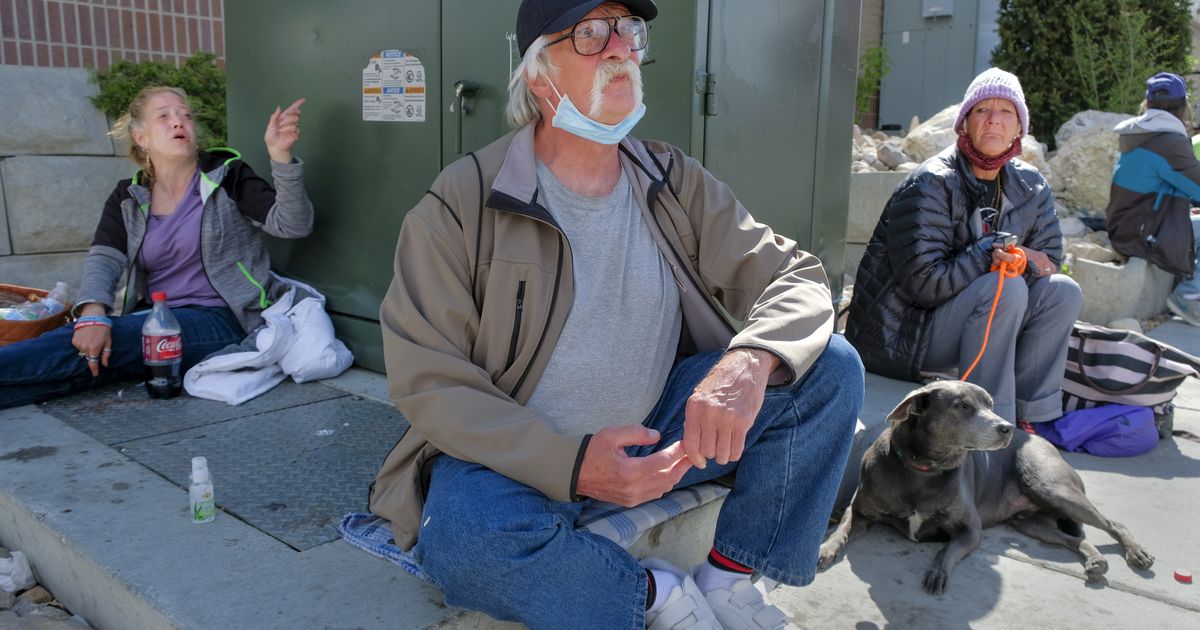UTAH – McCloy has stayed at the nonprofit on 33rd Street on and off since 2019, she said. But she misses an encampment in the adjoining street, where she used to have a tent and space to herself before Ogden city officials disbanded it in December.
“We’ve got to go inside now; we can’t camp out here no more,” McCloy said. “But I like camping.”
Ogden’s move made its unsheltered residents less visible — a shift recently noticed by Wayne Niederhauser, the state’s new homeless coordinator.
“I was up in Ogden the other day, and I didn’t see any encampments there,” he said in a recent interview with The Salt Lake Tribune’s editorial board.
“I drove out on Wall Avenue, and years ago I used to see that kind of thing in Ogden, but it’s not that way anymore,” he continued. “Is it because they’re attracted to Salt Lake because that’s where the services are? Is it they’re attracted to Salt Lake because of policy? That’s something I don’t know but have yet to discover.”
It’s “very apparent” that Salt Lake City is the “main epicenter” for homelessness in the state, he added, if only because of the “visual of people camping on the streets” in the capital city.
Niederhauser will visit Weber County on Friday to learn more about the community. Appointed to his new role last month, he has conceded he doesn’t have much on-the-ground experience working with people experiencing homelessness.
His initial impression spurred frustration among some service providers and homeless advocates in the Ogden area, who have long felt there’s a lack of awareness among statewide decision-makers that homelessness isn’t an issue exclusive to the Salt Lake Valley.
“I wonder where he went,” said Andi Beadles, executive director of Weber Housing Authority, “because it’s so visible to all of us.”
Many advocates and residents in the Ogden area are aware of the scope of homelessness in their community, a problem data shows has been growing steadily over the past few years as Utah grapples with an affordable housing crisis.
“There’s a lot of apartments that’ve gone up, been raised and opened, but none of them are low-income housing,” said Angelyne Cook, who has been staying at the Lantern House for about a month. “People like me, I’m on disability. I can’t afford $1,000 a month.”
She was one of several unsheltered individuals gathered outside the Lantern House Monday. Some said they want Ogden to allow tents again and camping within city limits. They have other needs, too: Help getting services while the Social Security office is closed due to the pandemic. Better access to internet. Bus passes. And, of course, more affordable housing options in Weber County.
(Leah Hogsten | The Salt Lake Tribune) Visitors at Ogden’s Lantern House sun themselves on the property where they are served meals and stay overnight on occasion, May 3, 2021.
‘It makes my heart hurt’
Angel Castillo, a homeless advocate and 2019 candidate for Ogden mayor, said she thinks homelessness is “not as visible of a challenge that it is in Salt Lake City.”
“We have such amazing access to outdoor space — trails, parks, places where people who have to camp because they don’t have a home can sort of go under the radar and not be seen,” she noted.
“There are less places to camp in Salt Lake City that are away from public eyes, but yet still get you to a bus or close enough to access the services you do need from a shelter provider,” she said. “We’re different in that aspect.”
And that difference means some county residents, as well as Utahns statewide, need some education to help them understand homelessness is an issue in Weber County, Castillo said.
Business owners and homeowners near the Lantern House, however, said they see people experiencing homelessness on a daily and sometimes hourly basis. The issue, they said, appears to be getting worse.
“It’s here. It didn’t go anywhere. Where’s it going to go?” said Chad Barnett, owner of DSI, a company that builds surveillance systems for commercial clients.
Barnett’s business is between the Lantern House and Jefferson Park, a public space where many of Ogden’s homeless spend their day, waiting for the shelter to provide a meal or open for the night.
“[I see] a lot of them walking their kids to school,” Barnett said. “They’re down and out, but they’re trying.”
Barnett said he has occasionally offered a job to some of the unsheltered people he sees passing by. And Allen Haddon, a nearby property owner, said he has let people he meets spend a night in his home.
“It makes my heart hurt to see people like that,” said Haddon, who has lived in the neighborhood for 12 years. “When I first moved in, I didn’t see anybody. Anybody. Now they come and go, and it’s always different people, all the time.”
(Leah Hogsten | The Salt Lake Tribune) Ogden resident Allen Haddon said the homeless foot traffic has increased in the the 12 years he’s lived at his home on 33rd Street, just east of the Lantern House, May 3, 2021. On occasion, Haddon has let people he meets spend a night in his home.
A growing number of unsheltered
While 2021 numbers have not yet been released, 2020 data shows there were 411 people experiencing homelessness in Weber and Morgan counties — a 9.3% increase from 376 in 2018.
That data, which shows the area has one of the state’s larger populations of people experiencing homelessness, is from the annual Point in Time Count. It provides a snapshot of how many people are homeless in the state on a single night each year.
The rate of homelessness in Weber County jumped 48% over four years, starting in 2014, and became proportionately higher than in Salt Lake County, according to a 2019 strategic plan commissioned by the Weber Housing Authority.
Niederhauser said in a follow-up interview with The Tribune on Tuesday that his comments were not meant to indicate that Ogden had “solved homelessness,” and said that he sees homelessness as a statewide challenge.
(Screenshot) The 2020 Point in Time Count, which provides a snapshot in time of how many people were experiencing homelessness in the state, found that there were 411 people experiencing homelessness in Weber and Morgan counties, a a 9.3% increase from 376 in 2018.
His remarks, he said, were meant to serve as a compliment to Ogden officials. “Whoever’s been involved, that whole area in Ogden has been transformed,” Niederhauser said. “And I was impressed.”
People working on the city’s response to homelessness “obviously are doing something that’s having some impact there,” he said, “because, you know, the visual is so much improved in Ogden versus what it was 15 years ago or 20 years ago.”
Niederhauser would have seen a different view last year, when an uncharacteristically large encampment grew outside the Lantern House shelter.
It became home to reportedly as many as 100 individuals experiencing homelessness, and city officials ultimately decided to disperse the camp early last winter. Officials said police received numerous calls to respond to assaults, harassment and campfires at the encampment, as well as trespassing, theft and vandalism affecting nearby businesses.
Just because the camp is gone doesn’t mean its occupants left Ogden, though. Previous tenants, like McCloy and her dog Dosha, either had to seek shelter at the Lantern House or find somewhere else to go, some setting up camps outside city limits or in other places that more easily fly under the radar.
“If you put a tent up, they’ll throw you in jail,” said Clive Fox, who waited with McCloy for the shelter to open for dinner.
The lack of tents and other visual reminders means the unsheltered often feel unseen, Fox said — even by Utah’s new homelessness coordinator.
“It’s way worse than he thinks it is,” he said.
There are a half dozen people Niederhauser could call who could take him to an encampment “right now,” Castillo said. And she hopes he will have meetings with those people on Friday to get a better sense of the challenges facing the community.






